
Wine Culture and Information since 2002 - Volume 22
 Wine Culture and Information since 2002 - Volume 22 |
|
Issue 60, February 2008 |
Contents |
|
|
What Are Labels For? |
|
Labels found on wine bottles are useful, there is no doubt about this. What are they for? An apparently easy question, indeed very complex. They identify a product - in our case a wine and its bottle - allow consumers to recognize that wine, while trying to catch the attention of new ones and to convince them to buy it. After all, a wine, at the end of production, must be sold: an undeniable law of market and business. Labels are only useful for presenting a wine and to make it visible on the shelves, just to attract consumers as to convince them to buy that bottle? If we look at the way labels are “made” and “presented”, this seems to be the main reason. If we carefully look wine labels, most of the information seem not to play the primary function of “giving information”, indeed to “convince” consumers that bottle contains the best wine in the world. No objection for this marketing principle, however it should be remembered final users of this market are consumers, and they should not be considered only numbers to be counted at the end of the year, during that period in which one usually assesses a profit or a loss. Wine labels represent, in the wide beverage and food scene, a singular and “atypical” case. Wine is a beverage as well as a food, of course it is not an essential food for nutrition, but it is however undeniable it is swallowed and, as such, it has effects on the body, not only referred to the obvious effects of alcohol. If we take a look at the labels of packaged foods sold in shops, we can notice, among the many things, they do not have the primary function of presenting and promoting a product only, they also have the function of informing the consumer about the list of ingredients and additives used for its production. The same can be seen in the labels of beverages and liquors, with the exception of beer which - in this sense - has a strong connection with wine. To this observation many could simply answer there is no need to list the ingredients in a wine: what else could be said as everyone knows it is made from grapes? Right, wine can also be made from grapes, but in every wine there is not only grapes. Or better to say, the grape is not there anymore, as it was transformed into a new product through a chemical process, although natural, called “fermentation”. Even in case it is expressed like that, many could still say it is fermented grape juice, and this too is something everyone knows, therefore is it really necessary to state it on labels? The problem is that wine is not that only. Wine is an extremely complex beverage, fruit of a long process beginning with grape and its juice. And in this long process, if one wants to obtain a quality product, it is not wise to neglect the development of things without a little of control, without using techniques and “ingredients” in order to prevent the spoilage of wine. Among the many, the widely debated sulfur dioxide which, thanks to its antioxidant and antiseptic properties, allows the wine to keep in good shape without being subjected to the attacks of oxygen and of time. Regarding this, it should be remembered sulfur dioxide is widely used by the food industry, not only in wine making, and it is also found in many foods and beverages, sometimes being used in quantities higher than the one used for the production of wine. Sulfur dioxide is not the only added “ingredient” found in a wine and, in case it was not added by man, it should be known it is however produced by yeast during fermentation. Sulfur dioxide is in fact the only chemical component to which legislators pointed their fingers to, forcing the producers of many countries - in recent times, the producers of European Union as well - to state in the label its presence in the form of “contains sulfites” warnings. Sulfur dioxide is not the only “extraneous” component to be added to a wine. It just takes a visit to the laboratory of any winery to understand in wine is added more than sulfur dioxide. Absolutely legal substances, no doubt about this, but of which no law requires producers to state their usage in labels. According to this point of view, current laws are very permissive and lacking, as in most of wine labels is not even found the list of grapes used for its production, as if grape variety would be irrelevant. Whoever is interested in wine - even a little - knows very well every grape gives the wine absolutely unique organoleptic qualities, therefore knowing the name of grapes used for the production of a wine is important. This could be objected by saying in the production of food there is no requirement in stating the variety of ingredients used, and grape - after all - is an ingredient of wine just like potatoes are for potato chips. What can be found in most of labels are just information for “convincing” consumers to buy that bottle, most of the times grapes and aging techniques are not even mentioned. Totally absent, with the exception of sulfur dioxide, the indication of other substances added during production. Everything is focused, in the most “detailed” cases, in praising that wine, of the care used for its production and that its quality is impeccable. A legal promotional message, no doubt about this, but is it acceptable a consumer does not know, honestly, what he or she is going to pour on the glass? Even though all the components added to a wine contribute to its stability, integrity and quality, is it not however right and honest to inform the consumer about the real content of a bottle? Of course, and this is a necessary clarification, not all the producers make a careless use of chemistry or other ingredients in order to improve their product, but it is however undeniable many wines are indeed a miracle of alchemy going far beyond the fermentation of grapes. In order to safeguard the most honest and scrupulous producers, as well as consumers, would not it be right to state in the label the list of ingredients used in a wine?
|
||||
Comparing Recioto della ValpolicellaThe great sweet red of Valpolicella protagonist of this month's comparative tasting, a sweet wine of full body and amazing aromas |
|
In past times there was Recioto della Valpolicella, then came Amarone, the robust and renowned red wine, famous in the world for its quality and elegance. The story tells Amarone was born from Recioto, by accident or by the will of a far-sighted viticulturist, a Recioto escaped from the control of events and which is allowed to complete fermentation, therefore becoming dry, that is Amarone, not sweet. Despite the son Amarone surpassed the father in notoriety, Recioto della Valpolicella is however an excellent wine, one of the few sweet red wines of the Italian enological scene. The name Recioto comes from the dialectal Veronese term recie - that is “ears” - with which are called the two upper parts of a grape bunch, ideally positioned like the ears in a head. Recie, because of the position they have in the bunch, receive a higher quantity of sun rays, therefore berries contain a higher quantity of sugar. The protagonist of Recioto della Valpolicella - as well as of Amarone - is Corvina, a red berried grape typical in Valpolicella and capable of making wines of full body. Corvina is not the only grape to be used in the production of Recioto and in the classic composition can be found, although in lesser quantities, the red grapes Rondinella and Molinara. To these grapes can also be added other varieties, of which the most common ones are Corvinone, and marginally, Dindarella, Rossignola and Oseleta, all being red. The grapes are allowed to dry for a period from 90 to 120 days, period during which the grape loses water and the quantity of sugar concentrates. During the drying process, and in favorable conditions, it can also develop Botrytis Cinerea, known as Noble Rot, which will contribute to increase the organoleptic complexity of wine.
|
|
Recioto della Valpolicella is generally produced in wintertime, at the end of the drying of grapes. The fermentation is pretty long and can also last more than 30 days, period during which the must is allowed to macerate with skins, therefore getting color, aromas and body. It will be fermentation to determine if the must will become Recioto or Amarone. When the fermentation goes through the whole process, the result is Amarone, whereas in case some of the sugar is kept, usually not more than 12%, the result is Recioto. The aging of Recioto is done in casks, whose size and characteristic are chosen by the producer according to the style of wine to be made. Traditionally, the aging of Recioto was done in a large cask, whereas today it is not uncommon the use of barrique, as well as it is not rare the use of both types. In fact, some producers prefer to begin the aging in barrique or in cask, and then to transfer Recioto - after some months - to the other type of container.
The tasting of Recioto della Valpolicella is a pretty singular experience for the study of sweet wines. Because of the grapes used and of their content in polyphenols - in particular Corvina - the sensation of sweetness will be followed by an unusual astringent sensation, something generally not found in sweet wines. In our comparative tasting we will evaluate three Recioto wines, aged in variable periods and one of them in barrique. The first wine is Speri's Recioto della Valpolicella Classico La Roggia, the only one being aged in barrique. The other two wines, Tedeschi's Recioto della Valpolicella Classico Capitel Monte Fontana di Tedeschi and Allegrini's Recioto della Valpolicella Classico Giovanni Allegrini, are both aged in cask, although for different periods. In the wines of the tasting, the dominant grape is Corvina, with the exception of Tedeschi's Recioto, in which are also found other varieties, such as Corvinone, Rossignola, Oseleta, Negrara and Dindarella. The three wines will be served at the temperature of 17° C (62° F) and, as usual, poured in three ISO tasting glasses.
|
||||||||
|
The characteristics of Recioto della Valpolicella's appearance are mainly determined by the grape which is found in higher quantity - Corvina - and, in particular, by the production technique. Corvina grape is in fact characterized by a pretty good coloring property, a quality which is also accentuated by the long period of maceration of the skins in the must, with the result of obtaining a wine with a pretty reduced transparency. Recioto della Valpolicella's transparency can in fact be pretty low, sometimes impenetrable to light. Also the color is affected by the qualities of Corvina. In Recioto is generally observed an intense and deep ruby red color, with nuances which in youth can also be purple red, although in most of the cases is ruby red. As the aging develops, a period which in Recioto can also be of tens of years, ruby red is progressively replaced by garnet red, therefore becoming - at the top of aging - brick red. We will begin the first phase of our comparative tasting from Speri's Recioto della Valpolicella Classico La Roggia di Speri. By tilting the glass on a white surface, we will begin by observing the base of the glass, from which will be evaluated the intensity of the color. This Recioto shows an intense ruby red color and a reduced transparency, the same color will also be observed in the nuance, towards the opening of the glass. Let's now pass to the evaluation of the second wine, Tedeschi's Recioto della Valpolicella Classico Capitel Monte Fontana. Also this wine will show an intense ruby red color, and also in the nuance can be seen the same color, whereas it will be noticed a lower transparency, almost impenetrable to light. The color of the third wine - Allegrini's Recioto della Valpolicella Classico Giovanni Allegrini - shows a deep and dark ruby red color, with nuances of the same color. Also in this Recioto the transparency is very low, almost impenetrable to light.
|
|
Just like for appearance, the aromatic qualities of Recioto della Valpolicella are mainly determined by Corvina grape. Also the production technique - and in particular the drying of grapes - contributes to the concentration of aromas, therefore making them richer and more complex. Recioto della Valpolicella is aged in cask - sometimes in barrique as well - a technique which will give the wine its aromatic qualities, therefore enriching it with tertiary aromas. The olfactory evaluation of Recioto allows the discovery of aromas mainly recalling red and black berried fruits - of which, the most typical ones are blackberry, plum and black cherry, also in the form of jams - as well as flowers, of which violet and dried violet are the main representatives. Among other common aromas in Recioto are mentioned chocolate, tobacco, vanilla, cinnamon, licorice and balsamic aromas of menthol and eucalyptus. Let's begin the evaluation of aromas from Speri's Recioto della Valpolicella Classico La Roggia. By holding the glass in vertical position and without swirling - in order to ensure the volatilization of lighter aromatic components only - we will proceed with the first smell which will allow the perception of opening aromas. From the glass will emerge clean, pleasing and pleasing aromas of blackberry, black cherry and dried violet, a very typical opening in Recioto, where blackberry usually plays the role of the protagonist. Let's now proceed with the swirling of the glass - therefore favoring the oxygenation of the wine and the volatilization of heavier aromatic components - and we will then do a second smell. The olfactory profile of this first Recioto will be completed by aromas of blueberry and prune followed by vanilla, tobacco, pink pepper, chocolate and evident hints of menthol and nail polish. Let's now proceed with the evaluation of the second wine of our comparative tasting: Tedeschi's Recioto della Valpolicella Classico Capitel Monte Fontana. By holding the glass in vertical position and without swirling, let's proceed with the evaluation of opening aromas, characterized by blackberry jam, black cherry jam and dried violet, a riper nose than the previous one. The olfactory profile will be completed - after having swirled the glass - by strawberry jam, vanilla, tobacco, cocoa, licorice and hints of nail polish, almond and menthol. The opening of the third wine - Allegrini's Recioto della Valpolicella Classico Giovanni Allegrini - is characterized by intense and clean aromas of blackberry jam, plum jam and dried violet, also in this case, a typical opening in Recioto. The olfactory profile will be then completed by blueberry jam, black cherry jam, tobacco, licorice, vanilla, walnut and chocolate, in which will also emerge pleasing hints of caramel, cinnamon and clover, as well as the balsamic hint of menthol.
|
||||
|
Among sweet wines, the tasting of Recioto della Valpolicella is an unique experience. As it is a red wine, besides the organoleptic qualities typical in sweet wines - in particular sweetness and smoothness - in Recioto della Valpolicella is also found the factor of astringency, given by grape's tannins and by the aging in cask. Because of the long maceration of the skins, astringency in Recioto can sometimes be very evident, a quality which is usually softened after some years of aging in bottle and thanks to the action of alcohol, sugar and roundness. The presence of polyphenols also contributes to give Recioto della Valpolicella a strong and robust body, also in this case, pretty uncommon in sweet wines. As already mentioned, astringency requires the presence of soft organoleptic qualities, which in Recioto is balanced by residual sugar and alcohol, which can also be higher than 15%. We will begin the phase of tasting from Speri's Recioto della Valpolicella Classico La Roggia. Since the first sip, the attack clearly show the typical organoleptic qualities of Recioto: astringency followed by sweetness, all being supported by alcohol. It should also be noticed the excellent correspondence to the nose, in particular the flavors of blackberry, plum and black cherry. The attack of the second wine - Tedeschi's Recioto della Valpolicella Classico Capitel Monte Fontana - is not different from the first one: astringency followed by sweetness and, soon after, the burning sensation of alcohol, very balanced. The same can be perceived in the third wine, Allegrini's Recioto della Valpolicella Classico Giovanni Allegrini: an astringent attack followed by sweetness and then alcohol, very balanced. It should be noticed, in all the three wines, the excellent correspondence to the nose and the pleasing roundness. Finally, another element to be considered is the differences in the use of cask and barrique.
|
|
In the final phase of the tasting, we will evaluate the taste-olfactory persistence of the wines and the sensations left in the mouth. The finish of Speri's Recioto della Valpolicella Classico La Roggia is persistent, leaving in the mouth intense and clean flavors of blackberry, black cherry and plum, very correspondent to the nose and very typical in Recioto. The finish of Tedeschi's Recioto della Valpolicella Classico Capitel Monte Fontana is very persistent, leaving in the mouth intense and clean flavors of blackberry, black cherry and plum to which follows a hint of strawberry. In the finish of the third wine - Allegrini's Recioto della Valpolicella Classico Giovanni Allegrini - can be appreciated a very long persistence, with intense and clean flavors of blackberry jam, black cherry jam and plum jam, more robust than the two previous wines. It should also be evaluated the final sensation of the three wines, in which can be perceived a strong and pleasing sweetness balanced by the astringency and by the full body.
|
Wines of the Month |
|
|
|
Score legend Prices are to be considered as indicative. Prices may vary according to the country or the shop where wines are bought |
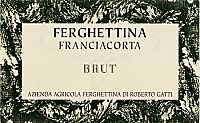
|
|
Franciacorta Brut |
|
| Ferghettina (Lombardy, Italy) | |
| Grapes: Chardonnay (95%), Pinot Noir (5%) | |
| Price: € 19.00 | Score: |
| This Franciacorta Brut shows a pale straw yellow color and nuances of greenish yellow, very transparent, fine and persistent perlage. The nose denotes intense, clean, pleasing and refined aromas which start with hints of apple, banana and pear followed by aromas of bread crust, yeast, praline, hawthorn and grapefruit. The mouth has good correspondence to the nose, an effervescent and crisp attack, however balanced by alcohol, good body, intense flavors, agreeable. The finish is persistent with flavors of apple, banana and grapefruit. This Franciacorta referments in bottle and stays with its yeast for 22 months. | |
| Food Match: Fried fish, Pasta and risotto with fish and crustaceans, Sauteed fish | |
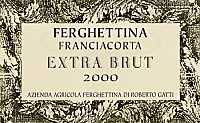
|
|
Franciacorta Extra Brut 2000 |
|
| Ferghettina (Lombardy, Italy) | |
| Grapes: Chardonnay (80%), Pinot Noir (20%) | |
| Price: € 28.00 | Score: |
| This Franciacorta Extra Brut shows a brilliant golden yellow color and nuances of straw yellow, very transparent, fine and persistent perlage. The nose reveals intense, clean, pleasing, refined and elegant aromas which start with hints of banana, peach and hazelnut followed by aromas of bread crust, yeast, acacia, hawthorn, raspberry, apple, tangerine, pear, praline, pink grapefruit and plum. The mouth has excellent correspondence to the nose, an effervescent and crisp attack, however balanced by alcohol, good body, intense flavors, pleasing smoothness. The finish is very persistent with long flavors of banana, peach, hazelnut and tangerine. A well made wine. This Franciacorta Extra Brut ages on its lees for 6 years. | |
| Food Match: Stuffed pasta, Roasted white meat, Roasted fish, Stewed fish | |

|
|
Castello Guerrieri Rosso 2004 |
|
| Guerrieri Rizzardi (Veneto, Italy) | |
| Grapes: Sangiovese (41%), Corvina (24%), Rondinella (21%), Molinara (9%), Croatina (5%) | |
| Price: € 14.90 | Score: |
| Castello Guerrieri Rosso shows a brilliant ruby red color and nuances of garnet red, moderate transparency. The nose denotes intense, clean, pleasing and refined aromas that start with hints of black cherry, plum and raspberry followed by aromas of blueberry, blackberry, cyclamen, vanilla, tobacco, chocolate and eucalyptus. The mouth has good correspondence to the nose, a tannic attack and pleasing roundness, however balanced by alcohol, good body, intense flavors. The finish is persistent with flavors of plum, blackberry and raspberry. Castello Guerrieri Rosso ages for 24 months in cask. | |
| Food Match: Roasted meat, Broiled meat and barbecue, Stewed meat, Hard cheese | |
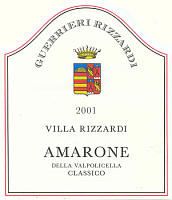
|
|
Amarone della Valpolicella Classico Villa Rizzardi 2003 |
|
| Guerrieri Rizzardi (Veneto, Italy) | |
| Grapes: Rondinella (48%), Corvina (25%), Barbera (10%), Sangiovese (9%), Corvinone (7%) | |
| Price: € 36.50 | Score: |
| This Amarone shows a brilliant ruby red color and nuances of garnet red, moderate transparency. The nose denotes intense, clean, pleasing and refined aromas which start with hints of blackberry, black cherry and plum followed by aromas of violet, blueberry, vanilla, tobacco, chocolate, mace, cinnamon and menthol. The mouth has good correspondence to the nose, a tannic attack and however balanced by alcohol, full body, intense flavors, pleasing roundness. The finish is persistent with flavors of blackberry, black cherry and plum. Amarone della Valpolicella Classico Villa Rizzardi ages for 12 months in barrique, 24 months in cask and about 6 months in bottle. | |
| Food Match: Game, Roasted meat, Braised and stewed meat, Hard cheese | |

|
|
Franciacorta Pas Dosé |
|
| Bredasole (Lombardy, Italy) | |
| Grapes: Chardonnay (50%), Pinot Nero (30%), Pinot Bianco (20%) | |
| Price: € 11.70 | Score: |
| This Franciacorta shows a brilliant straw yellow color and nuances of straw yellow, very transparent, fine and persistent perlage. The nose denotes intense, clean, pleasing and refined aromas which start with hints of plum, hazelnut and bread crust followed by aromas of banana, yeast, apple, hawthorn and grapefruit. The mouth has good correspondence to the nose, an effervescent and crisp attack, however balanced by alcohol, good body, intense flavors. The finish is persistent with flavors of banana, plum and grapefruit. The base wine used for this Franciacorta ages in steel tanks. | |
| Food Match: Aperitifs, Crustacean appetizers, Pasta and risotto with fish, Sauteed fish | |
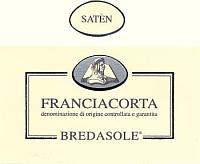
|
|
Franciacorta Satèn |
|
| Bredasole (Lombardy, Italy) | |
| Grapes: Chardonnay | |
| Price: € 11.70 | Score: |
| This Franciacorta Satèn shows a brilliant straw yellow color and nuances of greenish yellow, very transparent, fine and persistent perlage. The nose reveals intense, clean, pleasing and refined aromas that start with hints of banana, bread crust and plum followed by aromas of acacia, yeast, broom, hazelnut, apple, pear, grapefruit and vanilla. The mouth has good correspondence to the nose, an effervescent and crisp attack, however balanced by alcohol, good body, intense flavors, agreeable. The finish is persistent with flavors of banana, plum and hazelnut. The base wine used for this Franciacorta Satèn ages in barrique, referments and ages in bottle on its lees for about three years. | |
| Food Match: Fish and crustacean appetizers, Pasta and risotto with fish and crustaceans, Sauteed fish | |
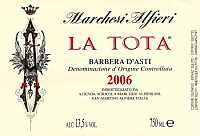
|
|
Barbera d'Asti La Tota 2006 |
|
| Marchesi Alfieri (Piedmont, Italy) | |
| Grapes: Barbera | |
| Price: € 10.50 | Score: |
| Barbera d'Asti La Tota shows an intense ruby red color and nuances of ruby red, moderate transparency. The nose reveals intense, clean, pleasing and refined aromas that start with hints of cherry, blackberry and plum followed by aromas of blueberry, cyclamen, violet and vanilla. The mouth has good correspondence to the nose, a slightly tannic attack and pleasing crispness, however balanced by alcohol, good body, intense flavors. The finish is persistent with flavors of black cherry, plum and blueberry. Barbera d'Asti La Tota ages for about 12 months in cask followed by about 6 months of aging in bottle. | |
| Food Match: Pasta with meat and mushrooms, Sauteed meat, Stewed meat | |

|
|
Barbera d'Asti Superiore Alfiera 2005 |
|
| Marchesi Alfieri (Piedmont, Italy) | |
| Grapes: Barbera | |
| Price: € 21.00 | Score: |
| Barbera d'Asti Superiore Alfiera shows an intense ruby red color and nuances of ruby red, little transparency. The nose reveals intense, clean, pleasing, refined and elegant aromas which start with hints of cherry, plum and violet followed by aromas of blackberry, blueberry, raspberry, vanilla, pink pepper, tobacco, cinnamon, chocolate and menthol. The mouth has excellent correspondence to the nose, a tannic attack and pleasing crispness, however balanced by alcohol, full body, intense flavors, pleasing roundness. The finish is very persistent with long flavors of cherry, plum and blueberry. A well made wine. Barbera d'Asti Superiore Alfiera ages for 12 months in barrique followed by about 8 months of aging in bottle. | |
| Food Match: Game, Roasted meat, Braised and stewed meat, Hard cheese | |
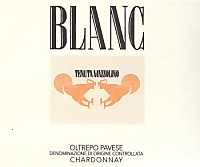
|
|
Oltrepo Pavese Chardonnay Blanc 2005 |
|
| Tenuta Mazzolino (Lombardy, Italy) | |
| Grapes: Chardonnay | |
| Price: € 9.00 | Score: |
| Oltrepo Pavese Chardonnay Blanc shows a pale straw yellow color and nuances of greenish yellow, very transparent. The nose denotes intense, clean, pleasing and refined aromas which start with hints of banana, pear and acacia followed by aromas of apple, plum, peach, melon, vanilla, hawthorn and hazelnut. The mouth has good correspondence to the nose, a crisp attack and however balanced by alcohol, good body, intense flavors, agreeable. The finish is persistent with flavors of banana, pineapple and hazelnut. Oltrepo Pavese Chardonnay Blanc ferments and ages in barrique for 12 months. | |
| Food Match: Stuffed pasta, Roasted white meat, Roasted fish | |
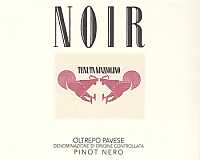
|
|
Oltrepo Pavese Pinot Nero Noir 2003 |
|
| Tenuta Mazzolino (Lombardy, Italy) | |
| Grapes: Pinot Noir | |
| Price: € 19.00 | Score: |
| Oltrepo Pavese Pinot Nero Noir shows a brilliant ruby red color and nuances of garnet red, moderate transparency. The nose reveals intense, clean, pleasing and refined aromas that start with hints of cherry, plum and rose followed by aromas of raspberry, vanilla, tobacco, strawberry, licorice, pink pepper, leather and menthol. The mouth has good correspondence to the nose, a slightly tannic attack and pleasing crispness, however balanced by alcohol, good body, intense flavors. The finish is persistent with flavors of cherry, plum and raspberry. Oltrepo Pavese Pinot Nero Noir ages for about 12 months in barrique. | |
| Food Match: Roasted meat, Broiled meat and barbecue, Stewed meat with mushrooms, Hard cheese | |

|
|
Valle d'Aosta Fumin Vigne La Tour 2004 |
|
| Les Crêtes (Vallée d'Aoste, Italy) | |
| Grapes: Petite Arvine | |
| Price: € 22.00 | Score: |
| Vallée d'Aoste Fumin Vigne La Tour shows an intense ruby red color and nuances of ruby red, moderate transparency. The nose reveals intense, clean, pleasing and refined aromas which start with hints of strawberry, cherry and raspberry followed by aromas of blackberry, geranium, blueberry, plum, cyclamen, tobacco, pink pepper and vanilla. The mouth has good correspondence to the nose, a slightly tannic attack and pleasing crispness, however balanced by alcohol, good body, intense flavors, agreeable. The finish is persistent with flavors of cherry, strawberry and blueberry. Vallée d'Aoste Fumin Vigne La Tour ages for 12 months in cask. | |
| Food Match: Broiled meat and barbecue, Stewed meat with mushrooms | |
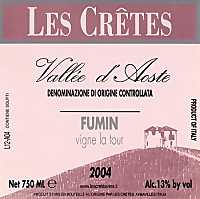
|
|
Valle d'Aosta Petite Arvine Vigne Champorette 2006 |
|
| Les Crêtes (Vallée d'Aoste, Italy) | |
| Grapes: Fumin | |
| Price: € 13.00 | Score: |
| Valle d'Aosta Petite Arvine Vigne Champorette shows a pale straw yellow color and nuances of straw yellow, very transparent. The nose denotes intense, clean, pleasing and refined aromas which start with hints of apple, plum and grapefruit followed by aromas of medlar, pineapple, jasmine, peach, elder, pear and broom. The mouth has good correspondence to the mouth, a crisp attack and however balanced by alcohol, good body, intense flavors, agreeable. The finish is persistent with flavors of apple, plum and grapefruit. This wine ages in steel tanks. | |
| Food Match: Pasta and risotto with fish and crustaceans, Fried fish, Sauteed fish | |
|
|
|
Adarmando 2006 |
|
| Tabarrini (Umbria, Italy) | |
| Grapes: Trebbiano Spoletino | |
| Price: € 14.00 | Score: |
| Adarmando shows a pale golden yellow color and nuances of straw yellow, very transparent. The nose reveals intense, clean, pleasing and refined aromas that start with hints of apple, medlar and plum followed by aromas of peach, pineapple, hawthorn, broom, honey, pear, hazelnut and hints of mineral. The mouth has good correspondence to the nose, a crisp attack and however balanced by alcohol, good body, intense flavors, pleasing roundness. The finish is persistent with flavors of apple, peach and hazelnut. Adarmando ages for at least 4 months in steel tanks followed by 3 months of aging in bottle. | |
| Food Match: Pasta and risotto with mushrooms and crustaceans, Sauteed white meat, Sauteed fish | |

|
|
Sagrantino di Montefalco Colle Grimaldesco 2004 |
|
| Tabarrini (Umbria, Italy) | |
| Grapes: Sagrantino | |
| Price: € 25,00 | Score: |
| The wine shows a deep ruby red color and nuances of ruby red, little transparency. The nose reveals intense, clean, pleasing, refined and elegant aromas which start with hints of black cherry, plum and blackberry followed by aromas of violet, black currant, vanilla, blueberry, tobacco, cocoa, mace, pink pepper and menthol. The mouth has excellent correspondence to the nose, a tannic attack and however balanced by alcohol, full body, intense flavors. The finish is very persistent with long flavors of blackberry, black cherry and plum. A well made wine. Sagrantino di Montefalco Colle Grimaldesco ages for 30 months in cask followed by 6 months of aging in bottle. | |
| Food Match: Game, Roasted meat, Stewed and braised meat, Hard cheese | |
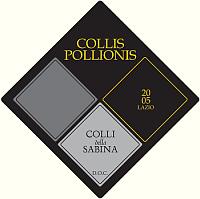
|
|
Colli della Sabina Bianco Collis Pollionis 2005 |
|
| Tenuta Santa Lucia (Latium, Italy) | |
| Grapes: Malvasia Bianca, Falanghina, Sauvignon Blanc | |
| Price: € 12.00 | Score: |
| This wine shows an intense greenish yellow color and nuances of greenish yellow, very transparent. The nose denotes intense, clean and pleasing aromas that start with hints of apple, plum and pear followed by aromas of almond, pineapple and hawthorn. The mouth has good correspondence to the nose, a crisp attack and however balanced by alcohol, good body, intense flavors, pleasing roundness. The finish is persistent with flavors of apple and plum. Colli della Sabina Bianco Collis Pollionis ages in steel tanks. | |
| Food Match: Pasta and risotto with fish and vegetables, Sauteed meat, Sauteed fish | |
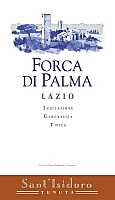
|
|
Forca di Palma 2006 |
|
| Sant'Isidoro (Latium, Italy) | |
| Grapes: Chardonnay (70%), Trebbiano Toscano (30%) | |
| Price: € 8.00 | Score: |
| Forca di Palma shows an intense greenish yellow color and nuances of greenish yellow, very transparent. The nose denotes intense, clean and pleasing aromas that start with hints of apple, pear and acacia followed by aromas of banana, peach and plum. The mouth has good correspondence to the nose, a crisp attack and however balanced by alcohol, good body, intense flavors. The finish is persistent with flavors of apple, pear and plum. Forca di Palma ages in steel tanks. | |
| Food Match: Crustaceans and fish appetizers, Vegetable soups, Risotto with Crustaceans | |
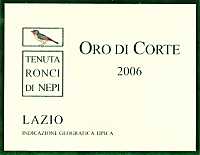
|
|
Oro di Corte 2006 |
|
| Tenuta Ronci di Nepi (Latium, Italy) | |
| Grapes: Chardonnay | |
| Price: € 9.00 | Score: |
| The wine shows a brilliant golden yellow color and nuances of straw yellow, very transparent. The nose denotes intense, clean and pleasing aromas that start with hints of apple, plum and banana followed by aromas of pear, acacia and hawthorn. The mouth has good correspondence to the nose, a crisp attack and however balanced by alcohol, good body, intense flavors, pleasing roundness. The finish is persistent with flavors of apple, plum and banana. Oro di Corte ages for 5 months in steel tanks. | |
| Food Match: Pasta with fish, Sauteed fish, Sauteed white meat | |
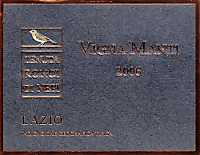
|
|
Vigna Manti 2006 |
|
| Tenuta Ronci di Nepi (Latium, Italy) | |
| Grapes: Chardonnay | |
| Price: € 18.00 | Score: |
| Vigna Manti shows an intense straw yellow color and nuances of golden yellow, very transparent. The nose denotes intense, clean, pleasing and refined aromas that start with hints of banana, apple and pear followed by aromas of plum, vanilla, hazelnut and honey. The mouth has good correspondence to the nose, a crisp attack and however balanced by alcohol, good body, intense flavors, pleasing smoothness. The finish is persistent with flavors of banana, apple and honey. Vigna Manti ages for 6 months in barrique. | |
| Food Match: Stuffed pasta, Roasted fish, Roasted white meat | |
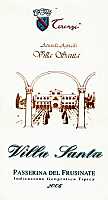
|
|
Villa Santa 2006 |
|
| Terenzi (Latium, Italy) | |
| Grapes: Passerina | |
| Price: € 6.00 | Score: |
| Villa Santa shows an intense greenish yellow color and nuances of greenish yellow, very transparent. The nose denotes intense, clean and pleasing aromas that start with hints of apple, pear and broom followed by aromas of hawthorn and plum. The mouth has good correspondence to the nose, a crisp attack and however balanced by alcohol, good body, intense flavors. The finish is pretty persistent with flavors of apple and plum. Villa Santa ages in steel tanks. | |
| Food Match: Vegetable appetizers, Risotto with Vegetables, Eggs | |
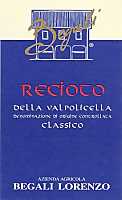
|
|
Recioto della Valpolicella Classico 2004 |
|
| Begali (Veneto, Italy) | |
| Grapes: Corvina (35%), Rondinella (30%) | |
| Price: € 17.00 - 50cl | Score: |
| This Recioto della Valpolicella shows a deep ruby red color and nuances of purple red, impenetrable to light. The nose reveals intense, clean, pleasing and refined aromas which start with hints of blackberry, black cherry and plum followed by aromas of dried violet, blueberry, vanilla, tobacco, chocolate, cinnamon, menthol and nail polish. The mouth has good correspondence to the nose, a sweet and tannic attack, however balanced by alcohol, full body, intense flavors, pleasing roundness. The finish is persistent with flavors of blackberry, black cherry and plum. This Recioto della Valpolicella ages for 12 months in cask followed by at least 6 months of aging in bottle. | |
| Food Match: Confectionery, Hard cheese, Jam tarts | |

|
|
Amarone della Valpolicella Classico Monte Ca' Bianca 2003 |
|
| Begali (Veneto, Italy) | |
| Grapes: Corvina (40%), Corvinone (35%), Rondinella (20%), Oseleta (5%) | |
| Price: € 30.00 | Score: |
| Amarone della Valpolicella Classico Monte Ca' Bianca shows an intense ruby red color and nuances of garnet red, little transparency. The nose denotes intense, clean, pleasing, refined and elegant aromas that start with hints of blackberry, plum and black cherry followed by aromas of violet, vanilla, raspberry, blueberry, tobacco, chocolate, cinnamon, mace and menthol. The mouth has good correspondence to the nose, a tannic attack and however balanced by alcohol, full body, intense flavors, agreeable. The finish is persistent with flavors of blackberry, plum and black cherry. A well made wine. Amarone della Valpolicella Classico Monte Ca' Bianca ages for about 4 years in cask followed by at least 8 months of aging in bottle. | |
| Food Match: Game, Roasted meat, Braised and stewed meat, Hard cheese | |
News |
|
In this section are published news and information about events concerning the world of wine and food. Whoever is interested in publishing this kind of information can send us a mail to our address.
|
CeleryFound in the gastronomies of the world, it is also used in pharmacology, in ancient times was used for magic rites, in the preparation of aphrodisiac potions and in funeral ceremonies |
|
Celery, that is Apium Graveolens, belongs to the family of Apiaceae, is a herbaceous biennial plant, with a cylindrical root in the cultivated varieties, whereas in wild varieties the root has a thin shape. Flowers are in the form of umbel, are made of about one hundred white-greenish flowers. Celery belongs to the same family of parsley and fennel. During the first year, from the root are generated leaves only, during the second year are developed ribs with flowers which can also reach one meter in height. Lower leaves have a long stem which expand to the base, wild plants have trilobed leaves, whereas cultivated varieties have pentalobed ones. Flowers are grouped in umbels at the end of branches. The calyx is very small, corolla is made from five white petals. Fruits are made of two achenes, close one to each other in a flat surface.
The plant of celery requires a lot of water, in fact, wild celery grows in humid, marshy and wild places only, in particular near the sea. The taste and the aroma of wild celery is not so pleasing. As opposed to wild varieties, cultivated celery has a good taste and a good aroma. Coming from Europe originally, where it is being cultivated since the seventeenth century, celery is now common in every region with a tempered climate. Today celery grows in most of the European territory, in Northern Africa, in Asia and in Southern America. The term “celery” comes from the Greek selion, mentioned in the books of Homer as crown for athletes. Greeks used to cultivate celery for the medical properties of its seeds, however they did not use it in cooking, as they believed it was a sacrilege. Homer mentioned it as a divine plant, whereas Achilles healed his horse thanks to the properties of celery. Since past times, celery was used both as a food and as a medicinal plant. From June to July, and every two years, in Nemea took place Nemean games, an event which, from 573 BC on, became a Panhellenic festival and winners were given a crown made of wild celery. In Corinth, during Isthmian Games, in 581 BC, in honor of Poseidon and Palaemon gods, winners were given a plant of celery. Plutarch described celery as a plant sacred to the “Great Mother” used in occasion of funeral ceremonies and consumed raw as an aphrodisiac. At those times it was believed a rib of celery boiled in nights of full moon and then applied to the skin of men and women, was useful for strengthening erotic charge, whereas in case a celery rib was placed in a bed, it was useful for strengthening love between a couple. The culture of that time strongly believed celery had aphrodisiac effects, and when a person gave some celery pith to a person of the opposite sex, this was considered as an explicit invitation of mating. Selinunte (Selinos in Greek, Selinus in Latin) was an ancient Greek city located in the South-Western area of Sicily: the name of the city derived from the wild celery settlers found there in abundant quantities. It seems Selinunte, at that time, was one of the most important places for the production and trading of celery. A plant of celery was also represented in the coins of the city. Hippocrates (460 BC - 377 BC), father of medicine, wrote «if your nerves are upset, celery will be your healing and remedy». Ancient Romans widely used celery in cooking, both for its unmistakable aroma as well as they believed it was a good remedy against the effects of alcohol. During Roman banquets was not rare to see commensals with celery crowns on their heads. In Middle Age celery played a very important role for the lives of European people, in particular for its medical properties. Hildegard of Bingen (1098-1179), also known as Saint Hildegard, benedictine mystics and religious, founder of Bingen monastery, used celery as a remedy against depression. Michele Savonarola (Padua, 1385-1466), one of the most famous physicians and humanists of the thirteenth century, discouraged women to the consumption of celery as it was believed to be a sexual stimulant even for those who wanted to stay chaste. The first information about the use of celery in cooking are dated back to 1623. In France, in 1700s at the court of Marquise de Pompadour, celery became very common as an erotic stimulant. In the 1800s its qualities were emphasized by the famous French gastronomer Alexandre Balthazar Laurente Grimod de la Reynière (Paris 1759-1837). The most common use of celery today is cooking, virtually found in every country of the world. It is consumed fresh and raw with olive oil, with cheeses, as a side dish, or used to give flavors to soups and stocks, as well as for the preparation of sauces. Celery is also used, together with carrot and onion, for the preparation of classic soffritto all'Italiana, base for many recipes in Italian cooking. In past times celery was cultivated in marshy areas, today, thanks to irrigation techniques, cultivation is possible in every type of soil. In order to make cultivation of celery profitable, today are used hybrid varieties, in order to ensure a higher yield and constant over time, as well as obtaining more and more resistant varieties. The result of this selection has allowed the cultivation of particularly productive varieties, such as giant golden celery of Castelnuovo Scrivia, in province of Alessandria, Italy. This variety of celery has large ribs, tender and aromatic, and can reach 60 centimeters in height. The type of soil is very important for the cultivation of celery, this must be fine and deep in order to allow a proper development of roots and a good availability of phosphor and potassium. Because of the considerable need of water, celery must be cultivated in a well irrigated soil. Harvesting is usually done by hand, with a preliminary selection and then a second one, in which celery is washed, in order to remove any residual, and part of the leaves are removed as they are not used in cooking.
|
||||||||||||
|
Celery usually found in shops comes from three different botanical varieties: dulce (sweet), or ribbed celery, is the most common type of celery with ribs and it is the most important commercial type; rapaceum, or tuberous celery, has a spherical root, very big and making the edible part; silvestre, cultivated for the production of leaves to be used as flavorings. Some varieties, coming from the past, have been rediscovered by modern genetics, of which the most common ones are:
Celery is known for its antirheumatic, diuretic, stimulant, depurative, digestive and sudorific properties. Despite in herbal medicine wild celery is considered to be the best, it can however be used the cultivated variety as well. Leaves, seeds and roots of the plant have diuretic, sudorific and depurative effects, used for stimulating the urinary system, as coadjuvant in case of rheumatism, uricemy and obesity. Leaves and roots have digestive properties and stimulate the secretion of bile. All these properties can be obtained both by consuming the fresh part or by drinking celery juice. An infusion of celery seeds can be of help against insomnia. Celery fruits favor the elimination of intestinal gas and have an anti-dolorific effect. Celery decoction was used as anti catarrhal and antiscorbutic. Modern pharmacology does not deny the properties of the plant, even though it found most effective remedies. Today celery is mainly used in cooking as flavoring and for the preparation of bases and sauces. Celery can be kept in fridge for a long time, however its ribs stay crunchy for just four or five days.
|
Wine Parade |
|
|
| The best 15 wines according to DiWineTaste's readers. To express your best three wines send us an E-mail or fill in the form available at our WEB site. |
| Rank | Wine, Producer | |
|---|---|---|
| 1 |
| Barolo Cannubi Boschis 2001, Sandrone (Italy) |
| 2 |
| Amarone della Valpolicella Classico 2000, Zenato (Italy) |
| 3 |
| Barolo Bussia 2001, Prunotto (Italy) |
| 4 |
| Collio Bianco Col Disôre 2004, Russiz Superiore (Italy) |
| 5 |
| Sforzato di Valtellina Canua 2001, Conti Sertoli Salis (Italy) |
| 6 |
| Soave Classico Monte Alto 2004, Ca' Rugate (Italy) |
| 7 |
| Bradisismo 2003, Inama (Italy) |
| 8 |
| San Leonardo 2001, Tenuta San Leonardo (Italy) |
| 9 |
| Sagrantino di Montefalco Collepiano 2003, Arnaldo Caprai (Italy) |
| 10 |
| Wine Obsession 2001, Vignamaggio (Italy) |
| 11 |
| Amarone della Valpolicella Classico Costasera 2001, Masi (Italy) |
| 12 |
| Chianti Classico Riserva Novecento 2000, Dievole (Italy) |
| 13 |
| Don Antonio 2003, Morgante (Italy) |
| 14 |
| Blanc des Rosis 2006, Schiopetto (Italy) |
| 15 |
| Nero al Tondo 2001, Ruffino (Italy) |
| |||||||
Privacy Policy | |||||||


| Copyright © 2002-2024 Antonello Biancalana, DiWineTaste - All rights reserved |
| All rights reserved under international copyright conventions. No part of this publication and of this WEB site may be
reproduced or utilized in any form or by any means, electronic or mechanical, without permission in writing from DiWineTaste. |